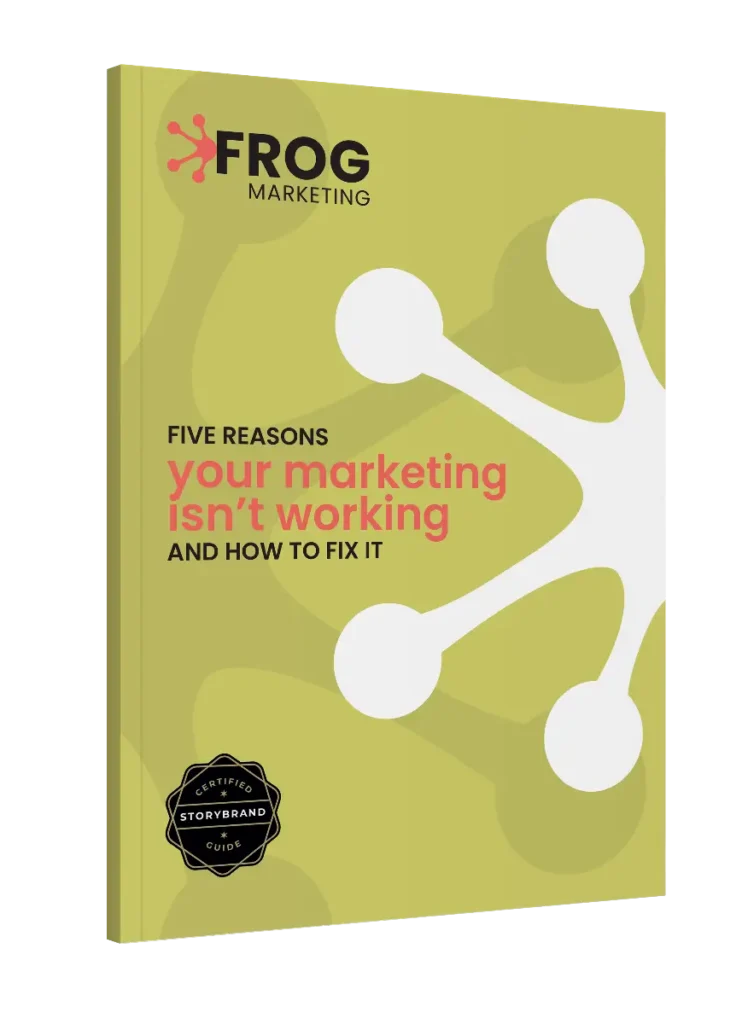Creating a strategy for marketing can feel overwhelming. You know you need one, but where do you even start? What should you be thinking about? And how do you make sure you’re not missing something crucial?
The truth is, most businesses don’t struggle with developing a strategy for marketing because they lack ideas – but because the ideas just aren’t structured enough and they aren’t necessarily addressing key business challenges or goals. Ideas are great but without strategic direction they lack the ability to create impact.
So how do you get strategic direction?
Strategy is essentially just making decisions. But how do you make decisions without knowing what the questions are? Without the right questions, you end up with a plan that’s either too vague to be useful or tactics that don’t actually move you towards your goals.
Over the last 20 years of helping businesses get more from their marketing, we’ve learned that a great strategy starts with great questions. The questions you ask determine the quality of the strategy you build. Ask superficial questions, get a superficial strategy. But asking the right questions give you insights that genuinely transform how you approach your marketing.
So in this article we look at the questions that really matter – the ones that will help you build a strategy for marketing that works for your business, your budget, and your goals.
Start With The Fundamentals: Your Business Goals
Before you think about tactics, channels, or campaigns, you need absolute clarity on where you’re trying to go. Your strategy for marketing should be built on solid business objectives, not vague aspirations. Ask yourself:
What are my actual business goals?
Not “we want to grow” – that’s too vague. What does growth mean for you? More revenue? Specific revenue targets? More clients? Better clients? Expansion into new markets? Be brutally specific here. One of the questions that I love to ask is: ‘If you could pick one client who you could have 100 like – who would it be” Then just keep asking why. Once you really unpack the answer to this question it can tell you a lot about how you want your business to look.
How should I set these goals?
At the most basic, you need to ask yourself: How much money do I need to make? How many customers do I need to make that happen? How many customers can I actually service? If you need more customers than you can handle in any given timeframe you need to change something about your pricing or delivery mechanism.
Beyond this your goals should be measurable, time-bound, and realistic. “Increase revenue by x% in the next 12 months” is a goal you can work with. “Get more customers” is not. But working out what ‘x’ should be is trickier. This is where knowing what your data is telling you is critical. What would achieving x mean you’d have to do and is this achievable? Don’t set yourself up to fail – there is nothing more demotivating.
What are the variables that affect whether I’ll achieve these goals?
Is it your pricing? Your conversion rate? The number of leads you’re generating? Your average order value?
Does this mean you need to increase the number of visitors to your site, get more of your existing visitors actually contacting you or raise prices? Maybe it’s all of these.
How will I achieve these goals?
Is this a digital strategy, is it leveraging a referral strategy, is it networking? Is it even marketing or can you achieve your revenue goal by raising prices? Improving retention? Increasing average order value? Sometimes the best marketing strategy involves fixing something else first. And if raising prices is part of the answer, does your messaging need to lean into the value more to justify it? Whatever the approach, understanding what your marketing needs to look like to implement this is crucial.
Understanding Your Current Position
A good strategy needs solid foundations. Understanding where you are starting from will help you understand what is achievable as well as how quickly you might get there and what is going on that will help or hinder you. Just as importantly, you can’t measure progress without a baseline, and you risk accidentally killing your best-performing activities if you don’t know what’s already working. Ask yourself:
What are my main business challenges right now?
Be specific. “Not enough leads” is different from “can’t convert the leads we have” which is different from “can’t retain the customers we win.” Each problem needs a different solution.
What are my main successes?
It can be tempting to skip this but it’s a really important question. What’s already working well? Where are you seeing traction? Can the things you are already doing really well be scaled up? What would the bottom line look like if you expanded the things that are working, rather than, or “as well as”, putting resources into new activity or development areas?
What does my data say?
Look at your website analytics, your sales data, your email open rates, your conversion rates. What story is your data telling you about where you are right now? What tools do you have for examining this? For websites, at the minimum you need to make sure you have Google Analytics and Google Search Console running. Some of the most basic key data to look at is:
- What % of your website visitors fill out a contact form?
- What % of your visitors end up on the contact page?
- What % of the visitors that end up on the contact form take action?
This is important because if your website isn’t converting visitors, you need to understand why and fix it before you invest in driving more traffic to it.
How do I interpret this data?
This is where many businesses get stuck. You’ve got the numbers, but what do they mean? Which metrics actually matter for your specific goals? A high bounce rate might be terrible for one business and completely fine for another, depending on what you’re trying to achieve.
It’s also important to look at the data in terms of specifics such as your industry, your market and the price point for what you are selling. For instance one of our clients has a minimum project value of £50,000, whilst another has an average service value of £200. The conversion rate expectations for these two customers will be very different. What looks like failure for one business might be excellent performance for another.

Knowing Your Customer (Really Knowing Them)
Effective marketing stems from a deep understanding of who you’re marketing to, what motivates them and how they’re feeling. Ask yourself:
Who is my ideal customer?
Go beyond demographics and start with the most significant questions: What do they want? What is stopping them from getting it and how does that make them feel?
What questions are my customers asking before they buy?
This is huge. A recent Gartner study found that the average buyer completes 70% of their research before they ever contact you. If you can answer the questions your customers are already asking, you become the obvious choice. What do they want to know about pricing? About how it works? About what results they can expect? Are you answering this anywhere?
What are my customers’ biggest fears and objections?
What’s stopping them from buying from you? Is it price? Trust? Uncertainty about whether it will work? You need to know these objections so you can address them in your marketing. But do it completely transparently and don’t shy away from answering difficult questions. You won’t be for everyone and that’s ok. If you’re not the right fit for someone, everyone’s time will be wasted. If you can talk about the thing that no one else in your industry is willing to address, you will instantly build trust and stand out from the crowd.
How does my customer make buying decisions?
Do they research extensively online? Do they ask peers for recommendations? Do they need multiple touch points before they’re ready? Understanding their buying journey helps you be there at the right moments with the right information.
Who are your competitors and what are they doing?
What are they doing well that you should learn from? What are they doing poorly that creates an opportunity for you? What are they completely ignoring that you could own?
What makes you genuinely different?
This can be a tricky one. Unless you’re making reusable chocolate tea pots it’s likely that someone else will be doing the same thing. However, the difference will likely be in a combination of your outlook, the way you deliver it, the quality, how well it works, and how you treat your customers. Ultimately, what will really differentiate you is how clearly you communicate this.

Assessing Your Resources and Capabilities
A realistic strategy for marketing isn’t just about what you should do – it’s about what you can realistically do with the resources you have. When you know what you have to play with, you can figure out what will give you the best gains in the quickest time with what you’re able to leverage. Ask yourself:
What should my marketing budget be?
The basic calculation depends on what you want to achieve. If you want to maintain your current position, industry benchmarks suggest investing around 5-7% of revenue. If you’re looking to grow, you should be aiming for 10-15% or more depending on how aggressive the growth plan.
However, if you’re project-based with high overheads, you need a more nuanced approach. You can use our marketing budgeting calculator to work out what makes sense for your specific situation. For a deeper dive into this topic, visit our article: How Much Should I Be Spending on My Marketing?
The challenge is that what it makes sense to invest doesn’t always tally with what you can actually invest. If your budget is more limited than the ideal, you need to really lean into quick wins that you can build on. Everything you do needs to be entirely driven by projected ROI and be incredibly effective. You can’t afford to waste resources on activities that might work – you need tactics that will deliver.
Do you have someone who can deliver the strategy and ensure you’re on track? Someone who can write? Someone who’s good in front of the camera? Someone who understands SEO? Someone who can design? Or are these all gaps you’ll need to fill? Your internal capabilities shape what you can execute in-house versus what you’ll need to outsource or hire for.
If I’m going to outsource, what level of help shall I seek?
There are three main models to consider:
Done for you is ideal if speed is essential and you have an agency that can pull everything together. Having one point of contact will absolutely make your life easier. When we work with clients, all third parties are managed by us so there’s one point of contact and someone has an overview tracking all activity.
Done with you is perfect if you want your team to develop these capabilities in-house for the future. When we’re managing marketing plans with in-house teams, much of the focus is on equipping them to deliver independently going forward, or helping you understand what a smart hire might look like. What teams value most in this model is the expert overview – a strategic partner who can help steer the ship, sense-check decisions, drive the strategy, and tweak where necessary.
DIY implementation works if you have capable people internally or established agency relationships, and you just need the strategic direction to point everyone in the right direction. If you want to try and do the whole thing in-house we have a great resource that pairs well with this article: The 90-Day Marketing Strategy Workbook.

Defining Success and Measurement
If you can’t measure it, you don’t know it’s working. Yes, some things are difficult to track, but there’s usually a way of evaluating success even if you can’t be 100% accurate on everything. The key is to define what success looks like first so you have something to benchmark against. Ask yourself:
How will I measure success for each channel and tactic?
What does success look like for your email marketing? For your social media? For your SEO efforts? Each channel needs its own success metrics.
Most digital tools will have their own way of tracking stats. For a high-level overview, these can usually be pulled into a dashboard using a tool like Reportz.io.
Where it’s difficult to track directly – like phone calls from your website or clicks on email addresses – you can add a Google tag to track engagement. This is also useful for assessing outbound links. For example, if you’re paying for membership to a professional body and want to assess whether people are actually interested in it, you can track how many people click through to that link from your site.
What are my key performance indicators (KPIs)?
Not every metric matters. Focus on the ones that actually tell you if you’re moving towards your goals.
How often should I review and adjust my strategy?
Strategy is making the best decisions you can at the time based on the information you have. But things change, and as you gather more information and try different things, you’ll often need to adjust and tweak.
Some of this will happen on the fly as you react to situations and experiment. However, it’s important to look at your strategy at regular intervals and update next steps and future phases accordingly. Your business model, market conditions, and economic changes will likely dictate how often you need to do this, but have a plan for the frequency that’s right for you – whether that’s monthly, quarterly, or annually.
Making Smart Decisions About Channels and Tools
The options available these days can feel completely overwhelming. There are so many things you could do but what SHOULD you do? Ask yourself:
What channels are available to me?
This is the starting point. List them all out so that you don’t forget any and you know it was a tactical decision to include or reject them, not an omission when you look back on your strategy.
Which channels make sense for my specific goals and audience?
Just because a channel exists doesn’t mean you should use it. Where does your audience actually spend time? Which channels align with your goals and budget? If you’re creating training for electric vehicles, Instagram will likely be too dry. If you’re selling zimmer frames, TikTok is likely a waste of time, but if you’re planning events for teenagers it’s likely at the top of the list.
What will give you the best ROI in the shortest time?
What are your quick wins? What can you do that will start generating results within weeks or months rather than requiring a year-long investment? SEO is a great long-term strategy but if you need more customers now, paid advertising will bring that instant cash that may help SEO become more affordable.
How can I use AI effectively and safely?
AI can be an incredibly powerful tool – from content creation to data analysis to customer service. But it needs to be used strategically.
Where can AI genuinely save you time or improve your results? Where do you still need human strategy and creativity? And how do you use these tools safely without compromising your brand or your data?
There are a few things to remember about AI – the key is that what you get out is only as good as what you put in. Keep in mind the following points:
It doesn’t know anything you don’t tell it or it can’t find on the internet. It will likely try and use well-regarded sites to pull information but even on these the information might not always be accurate, and if you are in a very niche sector its resources might be limited.
It’s great at collecting information but not always good at context and joining the dots. You need to be confident that you can bridge this gap and that you’re constantly checking for the nuances it might miss.
It can be generic and doesn’t always sound like you. You can train it to an extent but you’ll still need to get good at prompts and be prepared to heavily edit what it generates – fact-checking, removing repetition and making it sound like you. When you’re giving instructions, be as thorough in your briefing as you would with a new graduate and don’t forget to give it context.
AI is like a happy puppy – it wants to please. Constantly question it, challenge it and ask it for meaningful critique. AI has no critical judgment and will happily endorse mediocre work if you let it. Importantly, use your instinct – if it doesn’t feel right it probably isn’t.
Pulling it Together
These questions might feel overwhelming and that’s completely normal, but if you work through them systematically you can shape them into an actionable plan. To help you we’ve created a workbook you can use to keep you on track.
This might still be too much and this is often why many businesses choose to work with a strategic partner. Not necessarily because they can’t answer these questions, but because having someone guide you through the process, challenge your assumptions, and help you see what you’re missing makes a big difference to the quality of your resulting strategy.
We’ve spent 20 years helping businesses work through exactly these questions to create effective strategies for marketing that actually get results. We don’t just ask the questions – we help you interpret your answers, challenge your assumptions, and build a roadmap that gets you from where you are to where you want to be.
Want help working through this? Learn more about our marketing strategy services or book a free consultation to discuss your specific situation.
Prefer to work through this yourself first? Download our 90-Day Marketing Strategy Workbook – a practical tool that walks you through these questions and helps you build your own strategic plan. It’s free, actionable, and designed to give you an effective strategy even if you never work with us.




